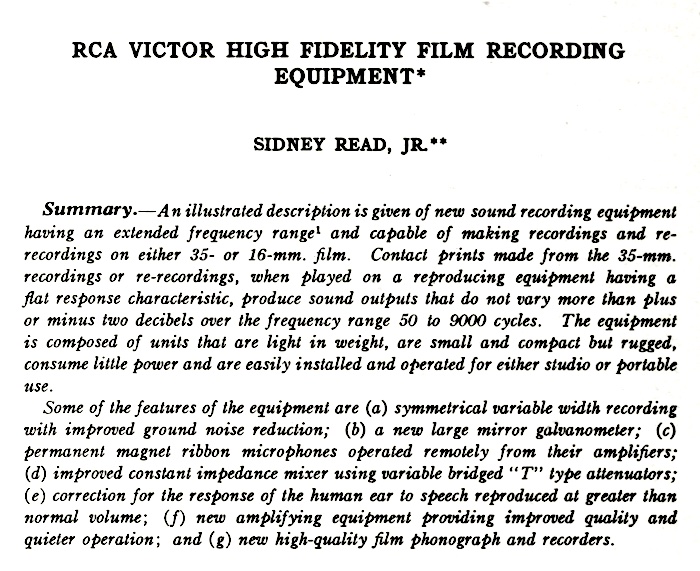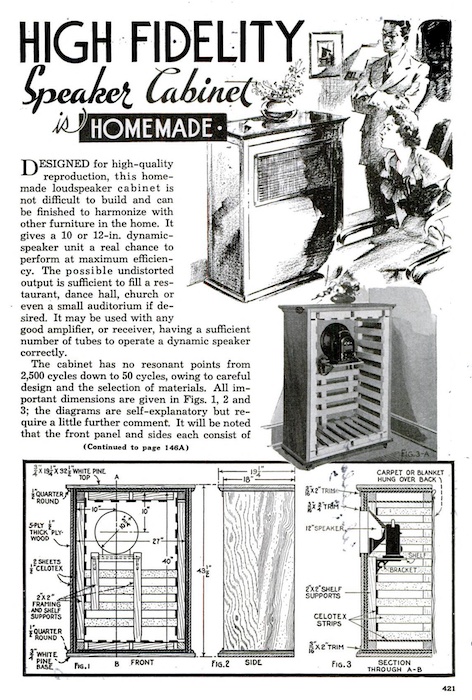EQカーブの歴史、ディスク録音の歴史を学ぶ本シリーズ。前回 Pt.14 では、1949年〜1950年(または1951年)の「回転数競争」における、各レーベルの参入状況を時系列に追ってみました。
On the previous part 14, I studied more on the history and chronology of which label joined which new format (33 1/3 rpm or 45 rpm) during the so-called “The Battle of The Speeds” era in 1949 to 1950 or 1951.
今回の Pt.15 はその続きなのですが、一休みして、1950年頃からの「ハイファイ」ブームの黎明期よりずっと前に生まれた、「ハイ・フィデリティ」という用語の歴史についてみていきます。
This time as Pt. 15, before I am going to continue learning the history of disc recording, I will look into the side story — i.e. the pre-history of the “Hi-Fi craze”, as well as the history of the term “High Fidelity” itself.
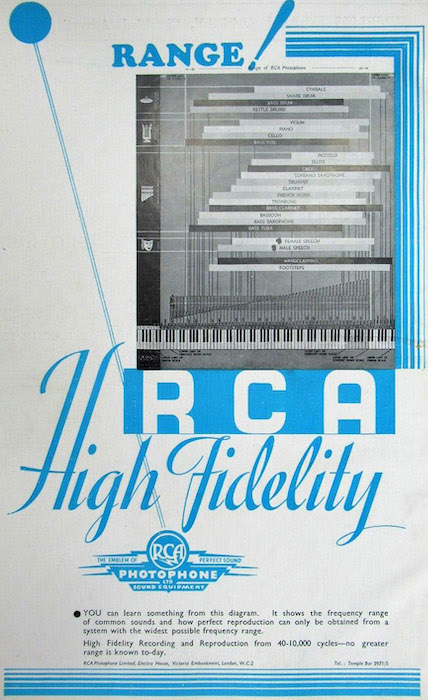
source: RCA Ad, Kinematograph Weekly, June 27, 1935, p. 76.
1935年の英国雑誌に登場した、RCA Photophone High Fidelity の広告
毎回書いている通り、筆者自身の学習過程を記したものですので、間違いの指摘や異論は遠慮なくお寄せください。
As I noted in every part of my article, this is a series of the footsteps of my own learning process, so please let me know if you find any mistakes on my article(s) / if you have different opinions.
今回も相当長い文章になってしまいましたので、さきに要約を掲載します。同じ内容は最後の まとめ にも掲載しています。
Again, this article become very lengthy — so here is the summary of this article (the same contents are avilable also in the the summary subsection).
1927年、まだ「ハイ・フィデリティ」に相当する音源も録音・再生機器もない時代、英国のスピーカ製造メーカの創業者 H.A. Hartley 氏が「ハイ・フィデリティ」という用語を生み出した。
In 1927, British speaker manufacturer’s founder H.A. Hartley invented the term “High Fidelity”, when there was no “High Fidelity” recorded sounds nor “High Fidelity” recording/reproducing equipment.
「ハイ・フィデリティ」という用語が米国に伝播した過程は現時点では不明だが、1929年には GE が論文中で使用したり、1933〜1935年には RCA Victor が複数の論文タイトルに「ハイ・フィデリティ」を登場させるなど、徐々に浸透していった。そして、RCA Victor の映画用光学録音技術として “RCA Photophone High Fidelity” という製品名および宣伝文句が生まれた。
I am not yet confirmed when and how the term “High Fidelity” was propagated to the U.S., but in 1929 GE published the technical paper containing the word “High Fidelity”, and in 1933-1935 RCA Victor published several papers with the titles containing “High-Fidelity”. Also in the 1930s, RCA presented the “Photophone” optical recording system for motion pictures; the phrase “RCA Photophone High Fidelity” was frequently used for advertising.
1930年代のトランスクリプション盤、光学録音技術、第2次世界大戦前のFM試験放送、アンプやスピーカの技術向上、ディスク録音再生技術の更なる進展、磁気テープの登場、低歪の重要性、など、以前より高品質な音源、および録音再生技術が進歩した結果、LP や 45回転盤登場とほぼ時を同じくして、オーディオ機器メーカやレコードレーベルなどによって「ハイファイブーム」が始まった。
Many technical improvements, from 1930s’ Electrical Transcriptions, optical recording technique for motion pictures, FM test broadcasting before the WWII, to improvements of amplifiers and speakers, disc recording/reproducing technology, the advent of magnetic tapes, importance of low distortion, etc. all evoled into the improvement of the “sound source” and “recording/reproducing equipments” — then soon after the advent of LPs and 45rpms, “Hi-Fi craze” arrived, mainly from audio equipment manufacturers and record labels.
1948年11月、アメリカ音響学会 (ASA) の「ハイ・フィデリティの要件」を論じるプレゼン及びディスカッションの場においても、「NABカーブの高域増幅は過剰すぎて歪の原因となる」という例の話が再び言及されており、当時の現場エンジニアや研究者の間では当たり前の共通認識であったことが伺える。
In 1948, interesting paper presentations and discussions on “What Constitutes High Fidelity Reproduction?” were made at the ASA meeting. Even in this discussion on the “Hi-Fi” controversy, that same old “excessive pre-emphasis of NAB recording curve” was mentioned, which surely had been a famous consensus among professional engineers and researchers.
Contents / 目次
- 15.1 Birth of the term “High Fidelity”
- 15.2 “What Constitutes High Fidelity Reproduction?” (Nov. 1948)
- 15.2.1 “The Acoustic Facsimile as a Goal”, by W.B. Snow
- 15.2.2 “Subjective Considerations for High Fidelity Reproduction”, by D.P. Loye
- 15.2.3 “The Reproduction of Sound”, by Harry F. Olson
- 15.2.4 “High Fidelity vs. Subjective Faithful Sound Reproduction”, by J.P. Maxfield
- 15.2.5 “The Limitations Imposed by Sound Recording on High Fidelity Sound Reproduction”, by S.J. Begun
- 15.2.6 Discussion
- 15.2.7 Popularization and background of “High Fidelity”
- 15.3 The summary of what I got this time / 自分なりのまとめ
15.1 Birth of the term “High Fidelity”
いわゆる「ハイファイブーム」がきたのは1950年代初頭と言われています。市販用コンポーネントオーディオ機器市場の興盛によって、オーディオ系雑誌も多く創刊しはじめた時期です。当時の各オーディオ機器メーカや各レーベルは、こぞって「ハイ・フィデリティ」「ハイファイ」を宣伝文句に取り入れました。
In early 1950s came the “Hi-Fi craze”, when many consumer audio component market started to grow rapidly, as well as many audio magazines were launched one after another. Many component manufacturers and record labels incorporated the term “High Fidelity” and “Hi-Fi” into their advertising statements.
この「ハイファイ」 (Hi-Fi, HiFi) という用語、そしてその元となる「ハイ・フィデリティ」 (High Fidelity) という用語が一般でブームになったのはまちがいなく、1940年代末に登場した LP と 45回転盤というマイクログルーヴ盤と関係しているはずですが、同時にそれが全てではないはずです。
To some extent, microgroove records such as LPs and 45 rpms, both of that came out in late 1940s, should be related to the “Hi-Fi craze”, as well as to the advent of the term “Hi-Fi” itself (and its original “High Fidelity”), but I guess LPs and 45 rpms were not the only reason for that.
この「ハイ・フィデリティ」という用語がいつ頃生まれたのか、を追ってみようとすれば、おそらくFMラジオ実験放送や映画(トーキー)、そして放送局用トランスクリプション盤などの1930年代にまで遡れそうに思えます。その当時は、(78回転で蓄音機や電蓄による)レコード再生においては、「高忠実度再生」なんて概念はなかったといってよく、高品質再生という点ではラジオや映画の遅れをとっていたことは間違いありません。
If I was going to dive into the history of when the term was born, I would track it back to the 1930s when FM test broadcasting, talking motion pictures, and electrical transcriptions were the cutting edge technology. At that time, at least in the consumer phonograph field (reproduction of 78 rpms by acoustic/electric phonographs ) there was no concept of “high fidelity reproduction” — sound quality of phonograph records was outdone by that of radio and talking movies.
そこで、今回はまず 「ハイ・フィデリティ(ハイファイ)」という用語そのものの歴史 を調べてみることにしました。
So I decided to first look into the history of the term “High Fidelity (Hi-Fi)” itself.
15.1.1 Were RCA? GE? the origin of the term “High Fidelity”?
手始めにざっくり検索してみると、例えば、論文誌 JSMPE (Journal of the Society of Motion Picture Engineers) の1933年5月号(Vol. 20, No. 5)に発表された論文が見つかり、そのタイトルが「RCA Victor High-Fidelity Film Recording Equipment」となっています。映画 (Motion Picture) 業界における光学式サウンドトラック録音 (Sound-on-Film Recording) 技術の論文で、「High Fidelity」という用語が使われた最初期の一例でしょう。
A quick web search reveals, for example, a paper published in the May 1933 issue (Vol. 20, No. 5) of JSMPE (Journal of the Society of Motion Picture Engineers), entitled “RCA Victor High-Fidelity Film Recording Equipment”. This paper is on optical soundtrack recording (Sound-on-Film Recording) technology in the motion picture industry, and is probably one of the earliest examples of the use of the term “High Fidelity” in this context.
1930年代に同論文誌に掲載された論文タイトルを調べてみると、他にも「High-Fidelity」を冠した論文がいくつか見つかりました。F.C. Barton 氏のディスク録音に関する論文を除き、映画技術であるようにみえます。また、これらの論文執筆者が、全員 RCA Victor Co. または RCA Victor Manufacturing Co. 所属者であることから、実は「High-Fidelity」という用語自体は、RCA 由来であった可能性 も考えられそうですが、さてさて。
Further search of the same journal in the 1930s resulted in several other papers with “High-Fidelity” in the titles. May of these appear to be related to film recording technology, except the F.C. Barton’s paper on disk recording. Also, since the authors of these papers all belonged to RCA Victor Co. or RCA Victor Manufacturing Co., so the origin of the term “High Fidelity” would possibly be from RCA…?
- RCA Victor High-Fidelity Film Recording Equipment, Sidney Read, Jr., Vol. XX, No. 5, May 1933, pp.396-436
- High-Fidelity Lateral-Cut Disk Records, Frederick C. Barton, Vol. XXII, No.3, Mar. 1934, pp.179-182
- Technical Aspects of the High-Fidelity Reproducer, E.D. Cook, No. XXV, No. 4, Oct. 1935, pp.289-313
- A New High-Fidelity Sound Head, F.J. Loomis and E.W. Reynolds, Vol. XXV, No. 5, Nov. 1935, pp.449-460
この、RCA による映画用光学録音再生システムは Photophone と銘打たれ、1930年代から「High Fidelity」と共に宣伝されていたようです。
This optical sound recording / reproducing system by RCA was labeled as “Photophone”, and since the 1930s it was frequently advertised along with the term “High Fidelity”.
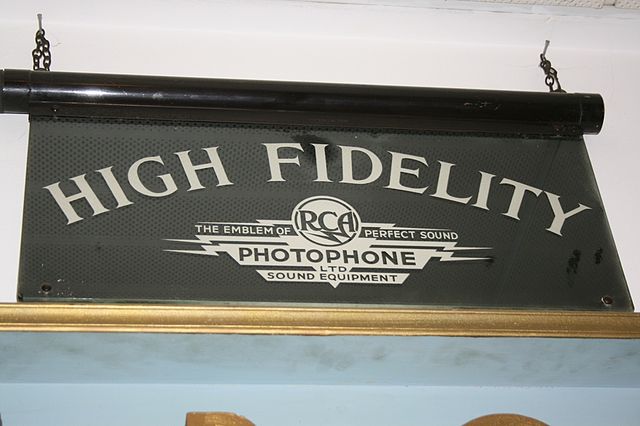
source: 1930’s illuminated sign for sound film system, Wikimedia Commons.
by YellowFratello, licensed under CC BY-SA 4.0.
ラジオ放送業界誌 Broadcasting 1932年10月1日号 (Vol. 3, No. 7) には、RCA Victor の Type 44-A ベロシティマイクと Type 41-A マイク用アンプの広告が掲載されていますが、ここでも「A high-fidelity audio system」という文言が使われていました。1930年代前半から、RCA は「High Fidelity」という用語を頻繁に使用していたことが伺えます。
Also in the October 1, 1932 issue of the famous broadcasting industry magazine Broadcasting, we see the RCA Victor’s advertisement of Type 44-A Velocity Microphone and Type 41-A Microphone Amplifier, featuring the phrase “A high-fidelity audio system”. These show that RCA frequently used the phrase “High Fidelity” already in the early 1930s.
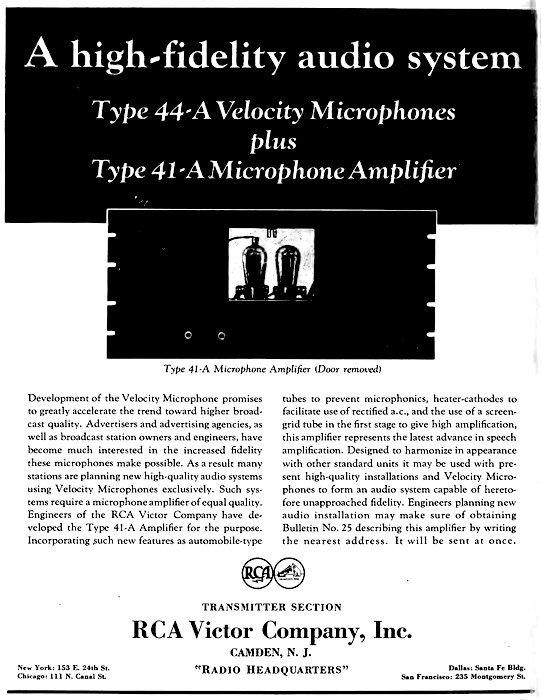
source: RCA Victor Ad, Broadcasting, Vol. 3, No. 7, October 1, 1932, p.32.
オーストラリアの雑誌?新聞?「Everyones」の1933年1月11日号にもこんな記事があります。RCA Victor の新しいサウンド・オン・フィルム(光学式録音)により「ハイ・フィデリティ」な映画音楽が可能になった、と。これはまさに上の1933年 Sidney Read, Jr. 氏の論文に呼応する内容ですね。
The January 11, 1933 issue of Australian magazine? newspaper? “Everyones” features the following news article, which says that RCA’s new Sound-on-Film optical recording technique enabled High-Fidelity motion picture sound — which definitely corresponds to the above May 1933 paper by Sidney Read, Jr.
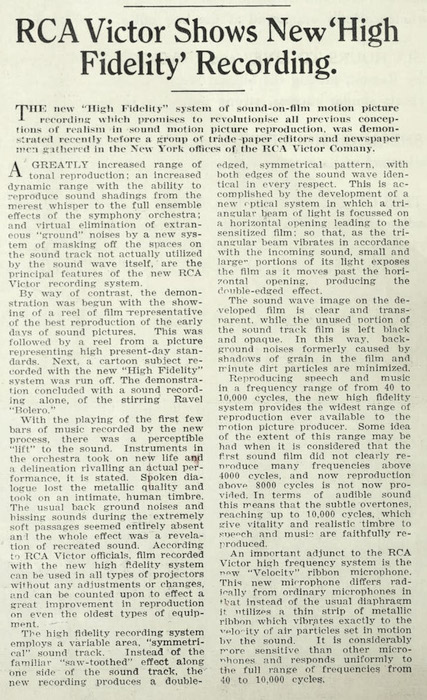
source: “RCA Victor Shows New ‘High Fidelity’ Recording”, Everyones, Vol. 13, No. 672 (11 January 1933), p.20.
…と書いていてアレなんですが(笑)、IRE(米国無線学会)の論文誌である「Proceedings of The Institute of Radio Engineers」の1929年3月号(Vol. 17, No. 3)に掲載された、ラジオ受信機に関する論文「Recent Developments in Superheterodyne Receivers」 (by G.L. Beers and W.L. Carlson) の中に「The new primary increases the effective secondary resistance at the low-frequency end of the range where it is normally too low for high fidelity」という表現が見られました。この論文執筆者両名は General Electric Company (GE) 所属です。GE 由来の可能性 も出てきました(笑)
… but wait, I found an older example featuring the term “High Fidelity”. The March 1929 issue of Proceedings of The Institute of Radio Engineers (Vol. 17, No. 3) contains the technical paper on radio receivers entitled “Recent Development in Superheterodyne Receivers”, authored by G.L. Beers and W.L. Carlson, which includes the phrase: “The new primary increases the effective secondary resistance at the low-frequency end of the range where it is normally too low for high fidelity”. Both of the authors were from General Electric Company (GE) — so was the origin of the term “High Fidelity” possibly be from GE…?
- Recent Developments in Superheterodyne Receivers, G.L. Beers and W.L. Carlson, Proceedings of The Institute of Radio Engineers, Vol. 17, No. 3, Mar. 1929, pp.501-505
15.1.2 H.A. Hartley in 1927!
そして「ハイ・フィデリティ」という用語のオリジナルがあっけなく見つかってしまいました。RCA 由来でも GE 由来でもありませんでした。インターネットすごい。
After all, I could found the real origin of the term “High Fidelity” — not from RCA, not from GE. Amazing is the internet!
ロンドンを拠点とするスピーカユニット製造メーカ Hartley Loudspeakers Inc. の創業者、H. A. Hartley が、1927年に「High Fidelity」という用語を思いついた、というのがオリジナルのようです。なんと、Bell Labs のラバーラインレコーダによる電気録音(Pt. 1 参照)の直後に、この用語がすでに生まれていたとは!
The originator of the term “High Fidelity” was H.A. Hartley, the founder of the London-based speaker factory Hartley Loudspeakers Inc. He “invented” the term in as early as 1927 — just a few years after the Bell Lab’s “rubber-line” electrical disc recording (see: Pt. 1) !
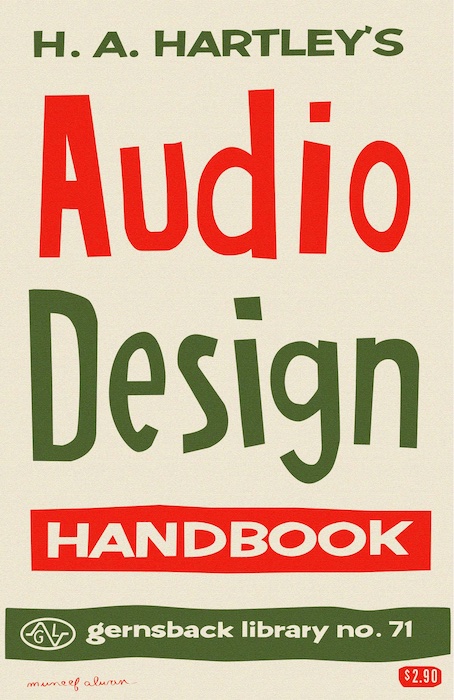
“H.A. Hartley’s Audio Design”, H.A. Hartley, Gernsback Library No. 71, 1958.
以下、Pt. 9 セクション 9.2.6 でも登場した、Gernsback Library の1冊、1958年に発行された「H.A. Hartley’s Audio Design」の中で、Hartley 氏自身が次のように書いていました。ちょっと長めですが、「オーディオファイル」という用語についても言及しているので、引用します。
Following is the excerpt from “H.A. Hartley’s Audio Design”, a book from the Gernsback Library (see also: Pt. 9, Section 9.2.6), written by Mr. Hartley himself. It is also interesting to read this as he also mentions about another term “audiophile” which was not his invention.
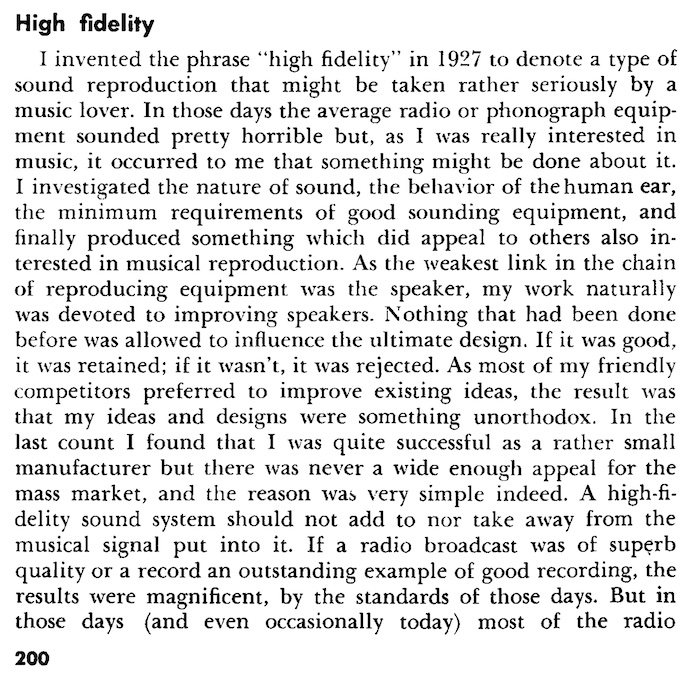
source: “H.A. Hartley’s Audio Design”, p.200, H.A. Hartley, Gernsback Library No.71, 1958.
HIGH FIDELITY
I invented the phrase “high fidelity” in 1927 to denote a type of sound reproduction that might be taken rather seriously by a music lover. In those days the average radio or phonograph equipment sounded pretty horrible but, as I was really interested in music, it occurred to me that something might be done about it. I investigated the nature of sound, the behavior of the human ear, the minimum requirements of good sounding equipment, and finally produced something which did appeal to others also interested in musical reproduction. As the weakest link in the chain of reproducing equipment was the speaker, my work naturally was devoted to improving speakers. Nothing that had been done before was allowed to influence the ultimate design. If it was good, it was retained; if it wasn’t, it was rejected. As most of my friendly competitors preferred to improve existing ideas, the result was that my ideas and designs were something unorthodox.
「ハイ・フィデリティ」というフレーズを発明したのは私で、1927年のことでした。音楽愛好家が真剣に取り組めるような音の再生方法を示すために、そのような用語を作り出したのでした。当時は、平均的なラジオや蓄音機の音はかなりひどいものでしたが、私は本当に音楽に興味があったので、(音質向上に向けて)自分にできることはなにかないだろうか、と考えだしたのです。そこで、音の性質、人間の耳の働き、良い音を出すための最低条件などを調べ、音楽再生に関心がある人たちにアピールできそうなものを作り上げました。当時は再生機器の中でもっとも弱かったのがスピーカだったので、当然ながら私はスピーカの改良に集中しました。至高の設計を目指し、既存の技術からの影響は一切排除しました。良いと分かったものはそのまま採用し、よくないものは全て却下しました。同業者の多くは、既存のアイデアを改良することを好みますから、私のアイデアやデザインは異端児のようなものでした。
In the last count I found that I was quite successful as a rather small manufacturer but there was never a wide enough appeal for the mass market, and the reason was very simple indeed. A high-fidelity sound system should not add to nor take away from the musical signal put into it. If a radio broadcast was of superb quality or a record an outstanding example of good recording, the results were magnificent, by the standards of those days. But in those days (and even occasionally today) most of the radio transmissions were distorted by the poor technical quality of telephone land lines and most of the records were even worse. The consequence was that my “high-fidelity” equipment made a lot of the music sound awful, and most people said they would rather have something moderately acceptable than a rare item of real enjoyment.
最終的に、小さな製造会社としてはなかなか良いものが作れて成功したと思いましたが、一般大衆向けに広くアピールすることはできませんでした。その理由は非常にシンプルです。ハイファイな音響システムは、元の音楽信号に何か足したり引いたりしてはいけません。もし、当時のラジオ放送が素晴らしい音質であったなら、あるいは当時のレコードが素晴らしい録音であったなら、(私が開発したスピーカ開発の)結果は、当時のレベルからすると素晴らしいものになっていたはずです。しかし当時は(また現在でもまだ一部は)ラジオ放送の品質は陸上電話回線の技術的な質の低さによって歪んでおり、レコードの品質はさらにひどいものでした。その結果、私の「ハイファイ」機器は、(ひどい音源をそのまま)ひどい音で再生してしまいました。そしてほとんどのリスナーは、本当に楽しめる希少な製品よりも、まぁこんなものかと受け入れられるレベルの製品の方がいい、と考えたのです。
Britain, therefore, was the pioneer country for high-fidelity. But it came too early and it is quite true, so far as my memory serves, that in all that long period between 1927 and 1939 I sold not a single speaker in the United States. The arrival of new techniques in recording provided a much better source of raw material for a high-fidelity installation (… snip …)
そういうわけで、イギリスは「ハイファイ」の先駆者的な国であったのです。しかし、(「ハイファイ」という用語の登場が)余りにも早すぎたので、私の記憶が確かならば、1927年から1939年までの長きに渡り、我が社のスピーカはアメリカで1つも売られなかったのです。その後、録音に関する新しい技術の登場により、ハイファイ再生用の素晴らしい素材(音源)が提供されるようになったのです。(…以下省略…)
(…) I did not invent the word “audiophile” hut I am grateful to the man who did because it is a very convenient term to apply to a certain type of audio equipment user. (… snip …)
(…) 「オーディオファイル」という言葉は、私が発明したわけではありませんが、ある種のオーディオ機器ユーザを指し示すのに非常に便利な言葉であり、この言葉を発明した人には感謝しています。 (… 以下省略 …)
“H.A. Hartley's Audio Design”, p.200, Gernsback Library No. 71, 1958この Heartley 氏による小冊子は、他のページも興味深い内容が満載ですので、ぜひ一読をお勧めします。
This booklet by Mr. Hartley is definitely worth reading all the way through, as it features many more interesting topics.
実際に Hartley 社が1930年代に製造したスピーカがどのようなものであったか、について、まとめたページがあったので紹介しておきます。
FYI, here is a page I found, that describes the details of what the Hartley speaker was like in the 1930s.
ともあれ、そうか、1927年〜1930年代の当時のイギリスのラジオ雑誌や論文などをひもといていけば、「ハイ・フィデリティ」という用語がどのように使われ、アメリカの研究・開発者に伝播していったのかがわかるということですね。けど、ここまでくると、本稿のスコープ外になってしまうため、ここでとめておきます。
Hmmm, so anyway, if I did further research of UK radio magazines and papers from 1927 to early 1930s, I would be able to find out when and how the term “High Fidelity” was spread to the engineers and researchers in the U.S. — but it may be far out of the primary topic I’ve been working on.
15.1.3 Electronics, Feb. 1934
アメリカに戻ります。ラジオを中心とした電子技術全般を扱う Electronics 誌1934年2月号の編集長コラムのタイトルとして「Do radio listeners want High Fidelity?」(ラジオ聴衆は「ハイ・フィデリティ」を望んでいるのか?)とされており、これが同誌における「ハイ・フィデリティ」の初出のようです。ここでは「ワイドレンジの音声信号伝送と受信」の意味として使われています。
Going back to America. In February 1934 issue of the Electronics magazine — dealing with electronics in general, but especially with radio and its technology — has a editor’s note, entitled “Do radio listeners want High Fidelity?”. In this column, high fidelity is defined as: “wide-range tone transmission and reception”.
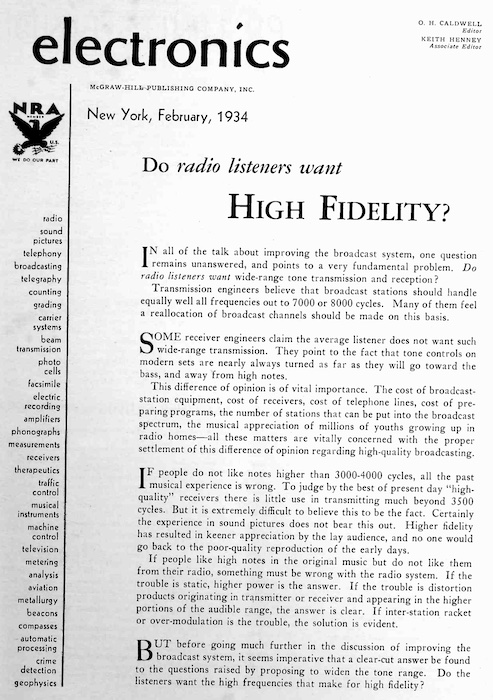
source: “Do radio listeners want High Fidelity?”, Electronics, February 1934, p.33.
このコラムでは興味深いことに、1934年当時のラジオ(つまりAM放送でしょう)において、「放送局側の設備は 7,000Hz〜8,000Hz までの音声信号を扱えるので、放送電波もこれを送信可能な割当にしてほしい」というエンジニアもいる一方で、「一般的なリスナーはそのようなワイドレンジ伝送を望んでいるわけではないから必要ない」というエンジニアもいる、と書かれていることです。ともあれ、当時の「ハイ・フィデリティ」とは、主として「どれだけ広い周波数帯域を記録・伝送・再生するか」を指していたことが分かります。
Fairly interestingly enough, this column describes that there were engineers who “believe that broadcast stations should handle equally well all frequencies out to 7,000 or 8,000 cycles”, while there were also engineers who “claim the average listener does not want such wide-range transmission”. In this paragraphs, it is understood that “High Fidelity” meant “recording/transmission/reproduction of wide-range tone” at that time.
15.1.4 Wireless Weekly (Australia), Aug. 31, 1934
オーストラリアのラジオ雑誌「Wireless Weekly」の1934年8月31日号(Vol. 24, No. 9)に掲載された、ラジオの近未来予測的な記事「The Near Future of Radio」という記事の中でも「High Fidelity」という用語について紹介しており、映画業界を中心にしたいろんな論文や雑誌記事に「ハイ・フィデリティ」という用語が出始めていたことが伺えます。
Aug. 31, 1934 issue of Australian amateur radio magazine “Wireless Weekly” (Vol. 24, No. 9) features the article entitled “The Near Future of Radio”, introducing the new phrase “High Fidelity”, which had been gradually popular in the talkie business, as well as in American radio papers and articles.
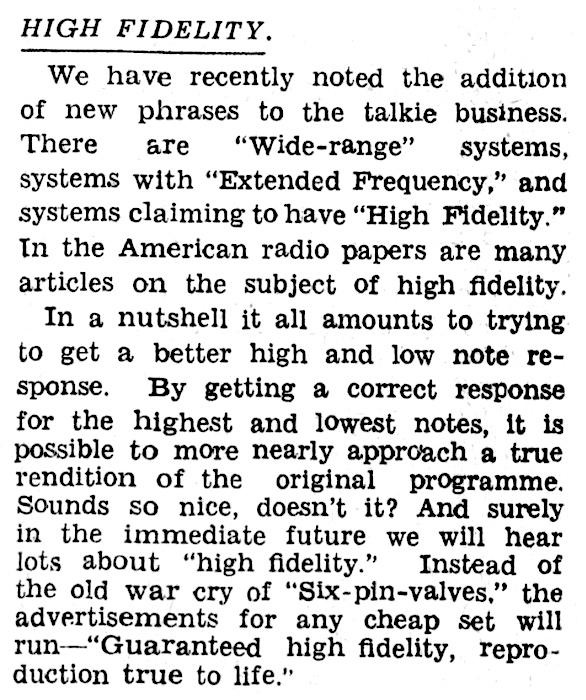
source: “The Near Future of Radio”, Wireless Weekly (Australia), Vol. 24, No. 9, August 31, 1934, p.26
HIGH FIDELITY
We have recently noted the addition of new phrases to the talkie business. There are “Wide-range” systems, systems with “Extended Frequency,” and systems claiming to have “High Fidelity.” In the American radio papers are many articles on the subject of high fidelity. In a nutshell it all amounts to trying to get a better high and low note response. By getting a correct response for the highest and lowest notes, it is possible to more nearly approach a true rendition of the original programme. Sounds so nice, doesn’t it? And surely in the immediate future we will hear lots about “high fidelity.” Instead of the old war cry of “Six-pin-valves,” the advertisements for any cheap set will run — “Guaranteed high fidelity, reproduction true to life.”
ハイ・フィデリティ
近年、トーキー業界に新たな用語が加わった。「ワイドレンジ」システム、「拡張周波数」を備えたシステム、そして「ハイ・フィデリティ」を備えている、と謳うシステムなどである。アメリカのラジオ紙には、ハイ・フィデリティをテーマにした多くの記事が掲載されている。一言でいうなれば「高音と低音のレスポンスをよくする」ための試みである。高音と低音の反応を正しくすることで、原音の忠実な再生により近づけることができる、というわけである。なかなか良いじゃないか。そして近い将来、我々は「ハイ・フィデリティ」という用語をますます耳にすることになるであろう。「6ピンの真空管」といった古い雄叫びに代わり、どんな安い音響システムの広告でも「ハイ・フィデリティを保証、忠実再生!」といった文言を目にすることになるであろう。
15.1.5 Radio, Feb. 1935
のちの Audio Engineering 誌の前身である Radio 誌でも、1935年2月号に「High Fidelity」という用語が初めて登場しています。McMurdo Silver 社のラジオコンソール(ラジオ受信機) MASTERPIECE III-X の広告の中で「Tone quality that out high fidelity’s high fidelity」(ハイ・フィデリティの中のハイ・フィデリティを凌駕する音質)というフレーズが登場しています。
Feb. 1935 issue of the Radio magazine (predecessor of the “Audio Engineering” magazine) also features the phrase “High Fidelity” for the first time in the magazine’s history. The term appears in the advertisement page of McMurdo Silver’s MASTERPIECE III-X radio receiver, which reads “Tone quality that out high fidelity’s high fidelity”.
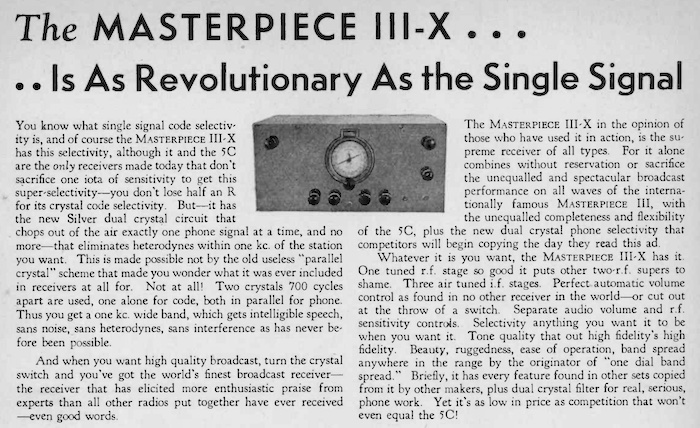
source: McMurdo Silver Masterpiece III-X Ad, Radio, Vol. 17, No. 2, February 1935, p.4
15.1.6 Popular Mechanics, Sep. 1937
一般向け科学技術雑誌 Popular Mechanics 1937年9月号 では、「High Fidelity Speaker Cabinet is Homemade」という、自作スピーカキャビネット制作記事が掲載されていました。当時も特に厳密な定義のない用語ではあったのでしょうが、1930年代末〜1940年頃から徐々に一般にも使われるようになったのかもしれません。
Sep. 1937 issue of the consumer science/mechanics/electronics magazine “Popular Mechanics” features a Do-It-Yourself article High Fidelity Speaker Cabinet is Homemade. Although I guess there was no consensus on the meaning of the term “High Fidelity” at that time, it seems that the phrase was gradually popular throughout the late 1930s to 1940s, among consumer magazines.
15.2 “What Constitutes High Fidelity Reproduction?” (Nov. 1948)
「ハイ・フィデリティ」関連で、最後にもうひとつ。Audio Engineering 1948年12月号に、非常に興味深いレポート記事が掲載されています。
Last of all, I would like to mention on a very interesting report article, published in the December 1948 issue of the Audio Engineering magazine.
1948年11月6日にクリーヴランドで開催されたアメリカ音響学会(ASA, Acoustical Society of America) での会合において、「ハイ・フィデリティとは」「ハイ・フィデリティ再生の要件とは」というテーマで開催された、名だたるエンジニア達によるパネルディスカッションの模様が仔細に報告されています。
The article reports the paper presentations at the Acoustical Society meeting in Cleveland, Nov. 6, 1948, followed by the panel discussion of high fidelity requirements by a group of distinguished engineers.
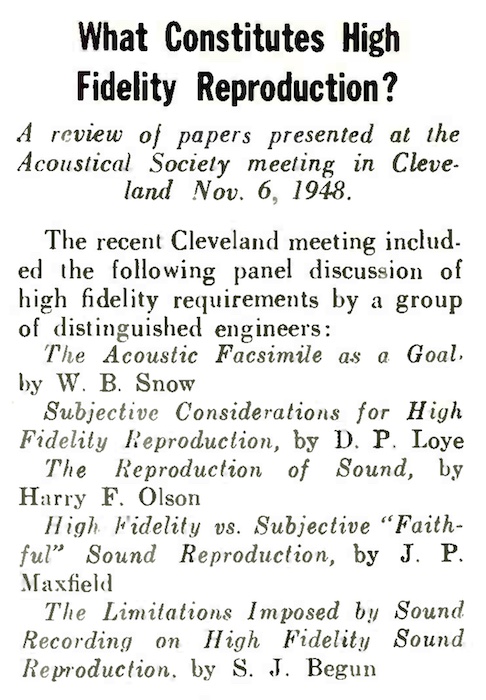
source: “What Constitutes High Fidelity Reproduction?”, Audio Engineering, Vol. 32, No. 12, December 1948, pp.8 & 36-37.
The recent Cleveland meeting (on Nov. 6, 1948) included the following panel discussion of high fidelity requirements by a group of distinguished engineers:
先日(1948年11月6日に)行われた、クリーブランドでのアメリカ音響学会の会合において、以下の通り名だたるエンジニア諸氏による「ハイ・フィデリティの要件について」パネルディスカッションが行われた。
- The Acoustic Facsimile as a Goal, by W.B. Snow
- Subjective Considerations for High Fidelity Reproduction, by D.P. Loye
- The Reproduction of Sound, by Harry F. Olson
- High Fidelity vs. Subjective “Faithful” Sound Reproduction, by J.P. Maxfield
- The Limitations Imposed by Sound Recording on High Fidelity Sound Reproduction, by S.J. Begun
当時の最先端を走る錚々たる大御所研究開発者たちによるプレゼンテーションが行われたのち、公開討論が行われました。この Audio Engineering 誌に掲載されたレポートは、1948年暮れという時点で、当時の先端研究者たちが、ハイ・フィデリティについてどのように捉えていたか、を知ることができる、非常に貴重な資料となっています。
After the presentation of these five papers by cutting-edge engineers/researchers, very interesting public debate was conducted. The entire report in this Audio Engineering magazine is an invaluable document of how leading-edge engineers/researchers regarded “High Fidelity” treated like.
15.2.1 “The Acoustic Facsimile as a Goal”, by W.B. Snow
最初は、ベル研で戦前に音響に関する数々の業績をあげた William B. Snow 氏による、ベル研の過去の研究内容概観と、「ハイ・フィデリティとリスナーの好みの違い」に関するプレゼンテーションです。
First presentation, reviewing Bell Lab’s long research history as well as the difference between High Fidelity and listener preferences, was by William B. Snow from Bell Labs, who had made tremendous contributions in the audio acoustics field.
W.B. Snow
W.B. Snow reviewed Bell Laboratories’ research of fifteen to twenty years ago: The first binaural system, with headphones; stereophonic transmission by wire, and by film. In these, equalization was used to provide flat response over a very wide frequency range. *High fidelity* requirements have been well known for years, and should not be determined by listener preference testing.
W.B. Snow 氏は、ベル研における過去15〜20年間の研究について振り返った。ヘッドフォンを使った世界初のバイノーラルシステム、有線によるステレオ伝送、フィルムによるステレオ伝送などである。これらの研究においては、非常に広い周波数帯域に渡りフラットな特性を得るためにイコライジングが使用されていた。「ハイ・フィデリティ」の要件は以前よりよく知られているものであり、リスナーの好みをテストすることによって判断すべきではない、と述べた。
On the other hand, in most applications high fidelity is uneconomical, and listener preference tests could make a valuable contribution by determining the conditions under which a satisfactory impression of the sound could be produced, or the limit of degradation of quality which would be artistically acceptable. He noted that it would be desirable to revive interest in a comparison of a multichannel narrow range system with a single channel wide range system. Nevertheless, the ultimate goal should remain acoustic facsimile.
一方、ほとんどの用途においてはハイ・フィデリティ(高忠実度再生)は不経済なものであるから、どのような条件で満足度の高い結果が得られるか、の条件を探る上では、リスナーの好みをテストすることも貴重な貢献をすることができ、同時に芸術的に許容できる音質劣化の限界値も明らかにできる、と述べた。更に Snow 氏は、周波数帯域の狭いマルチチャンネルシステムと、周波数帯域の広いシングルチャンネルシステムの比較に関心を持たせることも望ましい、と意見した。最後に、いずれにせよ(ハイ・フィデリティの)究極の目標は「音響の完全な再現・複製」である、と述べた。
“What Constitutes High Fidelity Reproduction?”, Audio Engineering, Vol. 32, No. 12, December 1948, pp.8 & 36-3715.2.2 “Subjective Considerations for High Fidelity Reproduction”, by D.P. Loye
続いて、ハリウッドの Electrical Research Products, Inc. 所属(すなわち Western Electric)の研究者、 D.P. Loye 氏による「映画における忠実再生について」のプレゼンテーションです。映画における音響の場合は、いわゆる「オーディオ」の世界とは異なる知見やテクニックが必要であることが述べられています。
Next presentation was conducted by D.P. Loye, a researcher at Hollywood’s Electrical Research Products, Inc. (thus Western Electric), discussing the problem of fidelity in motion picture reproduction, which somewhat differs from radio/phonograph reproduction field.
D.P. Loye
The next paper discussed the problem of fidelity in motion picture reproduction. For the highest fidelity a system of adequate power, free from harmonic and intermodulation distortion, and with a frequency range of 40 to 15,000 cycles would be required. Even though commercial systems do not use this full bandwidth, they do attempt to produce a subjectively flat response from studio air to listener’s brain. This presents problems which are peculiar to theater work. Theater reproduction must be at high level to override audience noise. Since speech is then reproduced at a considerably higher level than originally, the low frequencies must be attenuated in accordance with the shift in level along the Fletcher-Munson curves. It is also necessary to use *effort equalization* to compensate for the change in voice quality due to sound stage conditions. On a quiet sound stage the actor lowers his voice, which then acquires excessive lows and highs. A declamatory voice, as Mr. Loye showed, lacked lows and highs. Effort equalization in recording then will raise or lower the mid-frequency response so that the reproduced sound is subjectively correct. Originally developed empirically, laboratory studies provide the basis for present effort equalization practice.
Loye氏による次の論文は、映画再生における忠実再生の問題について論じたものである。ハイ・フィディリティ(高忠実度再生)を実現するには、十分な出力を備え、高調波歪や相互変調歪がなく、40Hz〜15,000Hzの周波数帯域を備えたシステムが必要となるであろう。市販用システムではこの全周波数帯域を使用していないが、スタジオの空気からリスナーの脳まで、主観的にフラットな応答を生み出そうと試みている。ここに劇場作品特有の問題がある。劇場(映画館)再生においては、観客の発する雑音に打ち勝つよう、再生レベルを高くする必要がある。つまり、本来の(記録された元の)音より高いレベルで再生されることになるので、Fletcher-Munson 曲線に沿ったレベルの変化に応じ、低周波帯域を減衰させなければならない。また、音響ステージの状況による声質の変化を補正するため、エフォートイコライザの使用も必要となる。静かな舞台においては俳優は声を低くし、結果として低域と高域が過剰となる。感情がこもった大声の時には、Loye が示した通り、逆に低域と高域が不足する。そこで、録音時に中域特性を上げ下げするエフォートイコライズを施すことで、主観的に正しい再生音を得られることになる。元々は経験的に開発されたものであり、その後の実験研究の成果が、現在のエフォートイコライジングの実践における基礎となっている。
He also discussed stereophonic reproduction, mentioning its use for sound reinforcement systems for orchestras. As applied to film in a 1940 demonstration, it added naturalness.
Loye氏はまた、ステレオフォニック再生についても論じ、そこで使われるオーケストラ用音響システム技術(SR)についても触れた。1940年のフィルムに適用し、自然さを加えることができた、という。
“What Constitutes High Fidelity Reproduction?”, Audio Engineering, Vol. 32, No. 12, December 1948, pp.8 & 36-3715.2.3 “The Reproduction of Sound”, by Harry F. Olson
さらに RCA の Harry F. Olson 氏が続きます。1930年代から数々の研究開発に従事し大量の特許も取得する天才技術者です。ここでのプレゼンは、今や伝説と化した、1947年(Olson 氏ご本人は 「1948年前後」と回想されています)の音響再生すりかえ実験に関する論文に関するものです。
Following was an interesting presentation by Harry F. Olson — a distinguished engineer at RCA, and had devopted himself into numerous research development since 1930s, and had many patents under his own name — , primarily based on that classical experiment of frequency range preference tests for reproduced speech and music in 1948.
周波数帯域の広さのみに目がいっていた研究開発界隈において、実験結果により歪の重要性を客観的に示したこと、当時はスピーカが歪の主要因と思われがちだったが、アンプにおける歪が重要であること、歪が多いから広周波数帯域再生が敬遠されていたこと、一般向けオーディオ機器のキャビネット(外観やシャーシ)と内部回路のコストに関する意見など、幅広い問題提起が行われています。
While the tonal range had long been the primary interest in the research development field, Mr. Olson’s experiment and his discussion here showed various topies: (1) the objective importance of the distortion in sound; (2) reducing intermodulation distortion of amplifiers being very important, while speakers were historically to blame; (3) less preference for wide range reproduction by listeners was due to the distortion; (4) the cost of cabinets vs that of circuits; etc.
Harry F. Olson
This proved to be the most informative and original paper of the symposium, and discussed listener range preference, analysis of typical present set performance, and analysis of tolerable faults. The first matter touched on was his well-known series of listener range preference tests using an acoustical filter. These indicated 69% preferring full range, and 31% preferring a 5000 cycle low-pass system cut-off. Not all of the 31% were actually against the wider range – they were often voting against a program that was disliked. In narrow bandwidth this would be less forcibly called to the ear’s attention, and hence be less objectionable.
Olson氏による本論文が、今回のシンポジウム中、最も有益かつ独創的な論文であり、試聴者の音域(周波数帯域)の好み、現在の典型的な再生システムの性能分析、許容できる欠陥の分析について論じたものである。本論文で最初に触れられているのは、Olson氏によるよく知られたアコースティック音響フィルタを使った一連のリスナー音域嗜好性テストである。69%のリスナーがフルレンジ再生を好み、31%が5,000Hzのローパスフィルタによるカットオフ再生を好むという結果が出た。実際に31%の被験者が高帯域再生に反対したわけではなく、内容を好まない再生音源に反対票を投じている場合が多かった。狭い帯域での再生の場合は、このようなことはあまり耳に残ることがなく、嫌われることがない、というわけである。
Tests using electronic systems often produce the opposite result, due to the many forms of distortion which may be present. He showed actual performance data on three typical sets in the $300 price class. All had very irregular acoustical response and a cutoff between 3000 and 4000 cycles. Directivity effect was high, even though reduceable at microscopic cost. Harmonic distortion reached 100% at 40 cycles because of the use of a pentode output tube without negative feedback, and the use of a 60 cent output transformer. In the middle range distortion was very great due to poor detector design.
電気システムを使ったテストの場合は、上とは逆の場合になる場合が多く、その多くが電気システムによって生じる様々な歪が原因である。Olson氏は、300ドルクラスの典型的な3つの再生システムについて、実際の性能テストデータを示した。いずれも音響特性は非常に不規則で、カットオフ周波数は3,000Hz〜4,000Hzあたりであった。指向性効果は、微小なコストで低減できるにも関わらず、高いものであった。負帰還のない5極菅出力と60セントの出力トランスが使われているため、高周波歪は40Hzで100%に達していた。中域においては、検出回路の設計が悪いためか、非常に多い歪が検出された。
Loudspeakers are often unjustly accused of responsibility for this intermodulation distortion. His data showed that the total set intermodulation was about five times that of the speaker alone.
この相互変調歪の原因として、スピーカが不当に非難されることが多い。Olson氏のデータによると、再生システム全体の相互変調歪は、スピーカ単体の相互変調歪の約5倍に達することが明らかとなった。
Irregularity in the response curve is accompanied by poor transient response. Oscillograms of the speaker response to a 150 millisecond tone burst indicated this. Quick buildup and decay of tone are needed for more reproduction of instruments such as the piano and guitar, and receiver loudspeakers often fail in this important respect – as the tone burst tests showed.
応答曲線が不規則であることにより、過渡応答の悪さも伴う。150msのトーンバースト信号に対するスピーカ応答をオシログラムで計測した結果がこれを示している。ピアノやギターのような楽器のより高忠実な再生には、音の立ち上がりの速さと減衰の速さ(すなわち優れた過渡特性)が必要となるが、この重要な側面を備えていないスピーカが多く見られることが、トーンバーストテストによって明らかとなった。
Amplifier distortion is more objectionable than older tests have indicated. 1/2 to 1% was just perceptible in a wide range system, and 4 to 5% was highly objectionable.
アンプの歪は、以前のテストが示していたより更に好ましくない結果となった。ワイドレンジのシステムにおいては0.5〜1%感じられる程度であるのに対し、(ワイドレンジではないシステムにおいては)4〜5%の歪が発生しており、これは非常に良くない結果である。
The public would like better sound, but few will pay very much extra for it. Furniture is very important, and a great deal of set cost lies in the cabinet. If two sets have equivalent cabinets, the public will pick the better sound; but if both cabinets and sound quality differ in opposite directions, prediction of the customer’s choice is difficult.
一般リスナーは、より良い音を聴きたいと望んでいるが、そのために大金を投じる人はほとんどいない。再生システムのキャビネット(外観)は非常に重要であり、実際システムのコストの大半はキャビネット部分で占められている。2つのシステムがあるとして、外観が全く同じであるならば、リスナーは音質の優れた方を選ぶだろう。しかし、外観が優れたシステム(しかし音は良くない)と、音質の優れたシステム(しかし外観は良くない)があるとすると、顧客がどちらを選択するか、予想は非常に困難となる。
Radio set and phonograph quality has improved in the last ten years without significant increase in price as a result thereof. Frequency range has increased at the rate of 100 cycles per year, representing slow but definite progress.
ここ10年間、ラジオや電蓄といったシステムは、価格が大きくあがることなく、品質が向上してきた。(再生可能な)周波数帯域は1年ごとに100Hzずつ広がってきており、ゆっくりであるが確実に進化してきている。
“What Constitutes High Fidelity Reproduction?”, Audio Engineering, Vol. 32, No. 12, December 1948, po.8 & 36-37上では「音響再生すりかえ実験」と書きましたが、実際は「リスナーの好む再生周波数帯域の実験調査」であり、すりかえが主ではありませんでした。
Here is the detail of the “listeners preference test on frequency range preference test”.
以下、音響工学を専門とする Cyril M. Harris 教授 (1917-2011) が 1989年に書いた「Harry F. Olson 1901—1982: A Biographical Memoir」の一節を引用します。
Below is the quote from “Harry F. Olson 1901—1982: A Biographical Memoir”, written by Professor Cyril M. Harris (1917-2011), who specialized in acoustics.
Following World War II, Dr. Olson continued his research in sound reproduction. One of his experiments, now considered a classic, determined the preferred bandwidth for the reproduction of music. Previous experimenters had found that listeners seemed to prefer a high-frequency cutoff of 5000 Hz for reproduced music. Dr. Olson carried out an experiment in which a small orchestra sat behind a visually opaque but acoustically transparent screen. The screen incorporated a concealed low-pass acoustical filter having an upper frequency cutoff of 5000 Hz. This filter could be opened or closed, allowing either the full range of frequencies to pass or the range only below 5000 Hz. The listeners were asked to select their preference between two conditions: full bandwidth or restricted bandwidth. There was overwhelming preference in favor of the full bandwidth. Next, the orchestra was replaced with a sound-reproduction system where the loudspeakers were located in the position of the orchestra, behind the screen. When the sound system was free of distortion, the listeners preferred the full bandwidth. But when he introduced small amounts of nonlinear distortion, the restricted bandwidth was preferred, thus demonstrating clearly the importance of high quality in audio systems.
第二次世界大戦後、オルソン博士は音響再生の研究を続けた。現在では古典とされている彼の実験のひとつが、音楽再生における好ましい帯域幅を測定するものであった。過去の実験で明らかになっていたのは、リスナー(被験者)は再生される音楽の高域が 5,000Hz でカットオフされたものを好む、ということだった。 オルソン博士は、視覚的には不透明だが音響的に透過なスクリーンの後ろに小編成のオーケストラを座らせて実験を行った。このスクリーンには、5,000Hz の高域カットオフを持つローパス音響フィルタが隠されていた。このフィルタは開閉可能で、全帯域(フルレンジ)を通過させることも、5,000Hz以下の帯域のみを通過させることもできた。リスナーには、全帯域と帯域制限とどちらが好みか選んでもらったところ、圧倒的に全帯域の方が好まれるという結果になった。次に、オーケストラの代わりに、スクリーンの後方、オーケストラの位置にスピーカを配置した音響再生システムを設置した。この音響システムで歪がない場合、リスナーは全帯域を好んだ。しかし、少々の非線形歪を導入したところ、帯域制限された音の方が好まれた。このようにして、オーディオシステムにおける高品質の重要性を明確に示したデモンストレーションであった。
“Harry F. Olson 1901—1982: A Biographical Memoir”, Cyril M. Harris, National Academy of Sciences, 1989さらに、上のコラムで触れられている「過去の実験」の例として、アメリカ無線学会論文誌(Proceedings of the I.R.E.) 1945年9月号(第二次大戦終戦直後!)に掲載された、CBS のエンジニア2名による論文を挙げておきます。この著者のうち Howard A. Chinn 氏は、NAB 標準規格委員会の執行委員会メンバとして尽力されていた方でもあります(Pt. 8 および Pt. 10 参照)。
As another side-note, here is an example of the “previous experiments”, a technical paper published in the September 1945 issue of the Proceedings of the I.R.E., authored by two CBS’ engineers. One of the author, Howard A. Chinn, was also an executive committee member of the NAB Recording and Reproducing Standards Committee (see also: Pt. 8 and Pt. 10).
この1945年の論文が興味深すぎ
— Kohji Matsubayashi (@kohji405mi16) April 29, 2023
Tonal-Range and Sound-Intensity Preferences of Broadcast Listeners
Howard A. Chinn & Philip Eisenberg
Proceedings of the I.R.E., Sep. 1945, pp.571-581
著者2名は CBS のエンジニア&研究者。Chinn 氏は NAB規格の執行委員会メンバ。https://t.co/Nf7TcrDtEG
一般ユーザ、すでにFM受信機を所有しているユーザ、ミュージシャン、など様々な被験者498名に対し、様々な音源のナローレンジ(AM相当)、ワイドレンジ(FM相当)など18種類の試聴テストを敢行、「好み」を統計的に分析するもの。
— Kohji Matsubayashi (@kohji405mi16) April 29, 2023
多くの被験者がナローレンジの方を好むという意外な結論が導かれた。
結果の解釈として「リスナーがそういう音に慣れているから」が大勢だったが、当時のエンジニア・研究者が「人間にはあまり知覚できないであろう」と思っていた「位相歪」(phase distortion) が関わってるらしい、とのちに研究が進み、1940年代末からのハイファイブームの布石となった。
— Kohji Matsubayashi (@kohji405mi16) April 29, 2023
当該論文アブストに書かれている結論
— Kohji Matsubayashi (@kohji405mi16) April 30, 2023
(a) 被験者は、ワイドレンジよりもナローレンジやミディアムレンジを好む傾向にあった。ただしどのレンジを選択するか、は、試聴した音源の種類ごとにある程度異なった。
(b)… pic.twitter.com/gjzDZ0L45n
15.2.4 “High Fidelity vs. Subjective Faithful Sound Reproduction”, by J.P. Maxfield
続いて、あのラバーラインレコーダを開発した、ベル研の J.P. Maxfield 氏による論文を、Frank Massa 氏が代読するプレゼンです。ここでも低歪の重要性に触れられていますが、全体としては「ハイ・フィデリティ」「忠実再生」「心地よい再生」という用語の区分についてのふわっとした内容だったようです。
Next speaker was Frank Massa, a substitute of Bell Lab’s J.P. Maxfield, who was one of the developers of the “rubber-line” recorder. The importance of low distortion is also mentioned here, while the presentation as a whole concentrated on the brief discussion of the distinction among “High Fidelity”, “Faithful Reproduction” and “Pleasing Reproduction”.
J.P. Maxfield
The author being absent, Frank Massa read a summary of Mr. Maxfield’s paper. He distinguished between high fidelity, faithful reproduction, and pleasing reproduction. The difference between high fidelity and faithful reproduction lay chiefly in the latter’s use of a certain amount of high end droop. The amount of droop needed depends on the amount of distortion present. If distortion is very low, the public will find that this procedure has made wide range reproduction quite acceptable. If distortion is marked, the public will not accept wide bandwidth.
Maxfield氏欠席のため、Frank Massa氏がMaxfield氏の論文要約を代読した。Maxfield氏は、「ハイ・フィデリティ(ハイファイ、原音忠実性)」「忠実再生」「心地よい再生」を分類した。ハイファイと忠実再生の主な違いは、後者がある程度高域減衰を適用していること、とする。高域減衰の適用度合いは、(高域の)歪の程度によって決まる。歪が少ない場合は、リスナーは広帯域再生を受け入れられると認識するであろう。歪が顕著な場合は、高帯域再生を受け入れないであろう。
“What Constitutes High Fidelity Reproduction?”, Audio Engineering, Vol. 32, No. 12, December 1948, po.8 & 36-3715.2.5 “The Limitations Imposed by Sound Recording on High Fidelity Sound Reproduction”, by S.J. Begun
最後のプレゼンは、圧電式カートリッジ用素子で有名な Brush Development の S.J. Begun 氏、この方は最初期の磁気テープ開発でも多大な貢献をされた方です。録音・再生両方面におけるハイ・フィデリティの要因を考察し、特に再生機器側の改良が必要だ、という内容です。
Last paper presentation was by Brush Development’s S.J. Begun, who was famous for early piezo-electric phono pickups and for early development of magnetic tape recorders. He described his opinion on High Fidelity both in recording and reproduction, stressing the importance of the improvement of reproducing systems.
S.J. Begun
Dr. Begun began by stating that economic considerations prevented high fidelity results from a sound recording system. He enumerated various well-known sources of distortion in disc, film, and tape systems, showing that each had faults. It was indicated that these could be minimized.
Begun博士はまず、コスト面での問題により、録音システムの原音忠実性が得られていない点を指摘した。また、ディスク、フイルム、テープ、それぞれのシステム(記録方式)で知られている歪の原因を列挙し、それぞれに欠点があることを示した。さらに、これらの欠点は最小限に抑えることが可能であることも示唆した。
Nevertheless, faithful reproduction has been attained by all recording means. At the present time, other elements of a reproducing system require much more improvement than does the recording-reproducing element.
それでもなお、いずれの記録方式においても忠実な再生が実現されてきた。現時点においては、録音再生における諸要素のうち、再生システムの要素がより多くの改良を必要としている。
“What Constitutes High Fidelity Reproduction?”, Audio Engineering, Vol. 32, No. 12, December 1948, po.8 & 36-3715.2.6 Discussion
そして最後に、登壇者と聴衆(とはいっても多くが著名な開発者・研究者でした)による、ディスカッションの模様が報告されています。あの超軽針圧ピックアップ開発者の Hunt 氏も登場します(Pt. 6 セクション 6.2 参照)。
After these paper presentations, speakers and audience (in fact most of them were famous developers and researchers) started discussion, including Dr. F.V. Hunt, a developer of ultra-light phono pickup (see also: Pt. 6 Section 6.2).
ここでもまた、NAB標準規格のプリエンファシスが過剰である、という例の話が出てきているのは興味深いです。そして、一般ユーザの間で「ハイファイ」ブームが起こる直前の1948年という時点で、研究者・開発者がどのような視点で課題感を持っていたのか、どのように解決しようとしていたのか、など、非常に興味深く感じられます。
It is very interesting to see that, even in the discussion of “High Fidelity”, distortion due to the excessive NAB’s treble pre-emphasis curve was mentioned. Also, the discussion as a whole is an exhibition of what issue(s) researchers/developers was aware of preventing high quality reproduction, and how they wanted to solve them, before the term “High Fidelity (Hi-Fi)” became very popular among consumers.
Discussion
The discussion was opened by F.V. Hunt, who commented that in his experience with wider range systems, the addition of an octave of bandwidth was accompanied by a listener demand for about 5 db more level. In discussing Dr. Begun’s remarks he noted that the present NAB pre-emphasis curve effectively guarantees excessive transcription distortion. There had been insufficient attention to the difference between transient response tests and the steady state. Finally, there was too great a difference between generally available reproducing system components and what had been used in the laboratory.
議論はまず F.V. Hunt 氏が口火を切った。彼が過去に行ったワイドレンジシステムの経験から、再生帯域が1オクターブ増えるごとにリスナー(被験者)が音量の5dBアップを要求する、とコメントした。また、Begun博士の発言について、現在のNABプリエンファシスがトランスクリプション(盤の再生)において過剰な歪を生んでいるとも指摘した。また、過渡応答テストと定常状態との差について十分な注意が払われていないことも指摘した。最後に、一般に入手可能な再生システムコンポーネントと研究室で使用されているものとの間にあまりにも大きな差があることを述べた。
Pat Norris remarked that, with radio sets improving at the rate of only 100 cycles per year, and his hearing decreasing at the rate of 200 cycles per year, the future sounded dark. He emphasized that modern apartment construction severely limited the usable volume range for many listeners, and that the use of full orchestral volume would quickly lead to a visit from the gendarmes. He also discussed his experiments in accustoming the non-technical to wider frequency range in small steps.
Pat Norris氏は、ラジオ(再生システム)は1年に100Hzずつ(再生帯域を)向上させているが、自身の聴力は年に200Hzずつ低下しているのだから、将来は真っ暗だ、と述べた。また、近代的な集合住宅の構造上、多くのリスナーにとっては使用可能な音量の範囲は非常に限定的なものとなり、オーケストラをフルボリュームで再生すれば、すぐに警察官の訪問を受けることになるだろう、と強調した。さらに、非技術者が少しずつ広い周波数帯域(による再生)に慣れていくための実験についても語った。
Harvey Fletcher noted that the discussion had not even touched on high fidelity, which had been available for many years, but rather on more practical systems. The problem is how to define the loss from ideal for any given set of system characteristics by a single number – a quality scale. It was interesting to recall that Pupin had said that if he had known the actual frequency spectrum of speech, he would never have developed the loading of telephone lines, for the cutoff of the first loaded lines was 1500 cycles.
Harvey Fletcher氏は、本会合で行われてきた議論では、長年存在した「ハイ・フィデリティ」にすら触れず、より実用的なシステムについてのみ議論してきたのでは、と指摘した。どのようなシステム特性であっても、理想からの損失を一つの数値、すなわち、品質尺度として定義するにはどうしたらいいか、それが課題だと述べた。(長距離電話通信の技術で重要な開発をした)Pupin氏がかつて「会話における周波数スペクトラムを当時知っていたら、電話回線の装荷コイルの発明すら行わなかっただろう」と話したことは興味深い、と語った。最初期の装荷ケーブルにおいてはカットオフは1,500Hzであった。
Harold Burris-Meyer protested the limitation of high fidelity to the audible range. Sub-sonic tones (10 cycles) had been used in a show to transmit emotions, and generally superaudible 18,000 cycles to produce irritability. The body responds to a wider frequency range than the ear. The problem is that of control, not of facsimile. Listener preference testing should determine the listener response without the use of questioning – which distorts the response. Intelligent installation is often as important as the apparatus used.
Harold Burris-Meyer氏は、ハイ・フィデリティ(の議論)が可聴域に限定されていることに抗議を唱えた。舞台では10Hzのサブソニックが感情を伝えるために使われ、イライラ感を表現するために超高域である18,000Hzが使われてきた。耳に比べ身体はより広い周波数帯域に反応する。つまり、音響の忠実再生が問題なのではなく、どう制御するかが問題なのである。リスナー(被験者)の嗜好性テストを行うにあたっては、リスナーへの質問を使わずに行われるべきだ。質問によるテストは、歪んだ反応を招くからだ。また、使用される機器(の品質)と同様、それら機器の適切な設置自体も重要である。
Morgan stated that perhaps a good binaural effect could be secured even though the second channel transmitted only frequencies below 1500 cycles.
Morgan氏は、バイノーラル再生において、片方のチャンネルが1,500Hz以下の周波数しか伝送していなかったとしても、恐らく優れたバイノーラル効果が得られるだろう、と述べた。
Hugh Knowles felt that some people prefer infidelity in reproduction. He protested the general lack of psychologists in listener preference testing work. H.F. Olson noted that his own test procedures had been checked by two psychologists.
Hugh Knowles氏は、再生におけるインフィデリティ(低忠実性)を好む人がいると感じている、と述べた。また彼は、リスナーの嗜好性テストにおいて、心理学者の関与が不足していることに抗議した。それに対し、H.F. Olson氏は、彼のテストにおいては、心理学者2名がチェックを行っている、と述べた。
The meeting then adjourned. Observers considered the meeting the most fruitful so far held on this controversial subject.
こうして散会となった。このような論議を呼ぶトピックについてのパネルディスカッションを傍聴した人々は、(全会合の中で)最も有益なものであったと感じたに違いない。
“What Constitutes High Fidelity Reproduction?”, Audio Engineering, Vol. 32, No. 12, December 1948, po.8 & 36-37本当に興味深い当時の議論です。このような、専門家、研究者、エンジニアなどの議論を経て、1950年代のいわゆる「ハイファイブーム」の勃興へとつながっていったのでしょう。とりあえず「ハイ・フィデリティ」という用語については、ここまでにしておきます。
Very interesting indeed to read such discussion that reflects what experts, researchers and engineers thought about the fidelity at that time. And such discussion later evolved into what we now know as the advent of the “Hi-Fi craze” in the early 1950s.
15.2.7 Popularization and background of “High Fidelity”
余談のはずがずいぶん長くなってしまいました。ともあれ、「ハイファイ」と略されることになる、この「ハイ・フィデリティ」という用語が1950年代頃に広く浸透するまでには、多くの技術開発や製品・サービス登場がありました。全てではないかもしれませんが、代表的なものだけでもこんなにあります。
What was supposed to be an aside turned out to be very long — anyway, before the term “High-Fidelity”, often abbreviated as “Hi-Fi” became widely accepted around the 1950s, there were many technological developments, improvements and product/service appearances. The following are just a few of the most representive examples:
- 1933年に発明され、1937年に米国で試験放送が開始、正式な商業放送が1941年に始まった FM(周波数変調)方式のラジオ放送と、それによって向上した各種周辺技術
- 1930年代〜のトーキー映画における 光学式録音技術 の発展
- 主に映画館用システムから発展していったスピーカに関する技術や音響に関する理論の発展
- 第二次世界大戦中に英国の D.T.N. Williamson 氏によって開発され、1947年に回路図が出版された、当時としては画期的なウィリアムソン・アンプの開発
- 1928年にドイツの Fritz Pfleumer 氏によって開発され、1940年代後半から米国のプロ市場で一気に普及した 磁気テープ
- 1938年に Pierce & Hunt 両氏によって開発された、(当時としては)超軽針圧で再生可能なピックアップと、そこから影響を受けて戦後に開発された各種ピックアップ
- 第二次世界大戦中に研究が進んだ、ディスク再生時のトレーシング歪と高調波歪の知見や、針先や音溝の形状のノウハウ
- 1948年に登場した Columbia による マイクログルーヴ LP と、1949年に登場した RCA Victor の マイクログルーヴ 45回転盤
- FM (Frequency Modulation) Broadcast, which was invented in 1933, first test broadcast in 1937, and officially started in 1941; as well as the development of its peripheral technology
- development and improvement of optical sound-on-film recording technology for talkie moving pictures in the 1930s
- development and improvement of loudspeakers technology and acoustic theory, primarily originated from the development of motion picture theater system
- development of Williamson Amplifier, originally developed by D.T.N. Williamson during the WWII and its circuit being published in 1947
- advent of magnetic tape, originally invented by Fritz Pfleumer in 1948, Germany, and which became rapidly popular in the professional recording fields
- development of pickup with ultra-light needle pressure by Pierce & Hunt in 1938, and its successors
- further research on tracing distortion and harmonic distortion on disc reproduction, as well as know-hows on stylus / groove shape
- advent of Columbia’s Microgroove LPs in 1948; and RCA Victor’s Microgroove 45 rpms in 1949
これら記録・伝送・再生に関するさまざまな技術要因の発展が、1940年代後半に一気に花開き、以前にはないほどの高品質再生の可能性が開かれたことにより、ちょうどいい塩梅のバズワードとして「ハイ・フィデリティ」が使われるようになり、その省略形としての「ハイファイ」も市民権を得た、という流れでしょうか。
Such improvements and developments above, that closely related to recording/transmission/reproduction, came togethered and blossomed rapidly in the late 1940s, resulting in the possibility of higher-quality sound reproduction. Then the term “High Fidelity” gradually came into use just as a salutary buzzword, along with the abbreviation “Hi-Fi”.
ちなみに、オーディオファン向け雑誌 「High Fidelity」の創刊号は、1951年4月に発行されました(1951年夏号)。
By the way, the first issue of one of the early consumer “audiophile” magazines “High Fidelity” was published in April 1951, as “Summer 1951 issue”.
本稿は、「ハイ・フィデリティ」という用語の歴史探究が主テーマではないため、とりあえずこの程度にしておきますが、この用語の歴史を本気で深掘りするのも非常に楽しそうですから、またいつかあらためて取り組んでみたい気もします。
As this weblog article is not primarily a historical exploration of the terminology of “High Fidelity”, so I will leave it at that for now. However, as I found it very interesting to do further exploration of it, I think I will come back to the topic sometime in the future.
15.3 The summary of what I got this time / 自分なりのまとめ
1927年に英国で生まれ、1930年代に一部業界で使われ、1950年頃を境にバズワード化した「ハイ・フィデリティ」という用語の歴史を追ってみましたが、その用語の意味するところは、時代によって、そして技術の進化過程において、徐々に変わってきていたことが分かり、非常に興味深かったです。
So here we have learned the history of the term “High Fidelity” itself, which was invented in 1927; which was propagated to the U.S. in the late 1920s to early 1930s, began extensively used in a certain field; and which in around 1950 became the buzzward in the industry and the market. On the other hand, I felt it very interesting that the meaning of the term gradually changed with time, and in the process of technological evolution.
さてさて、今回の内容をざっくりまとめると、こんな感じでしょうか。
…so, the rough summary of my understanding in this Pt.12 article would be something like this:
1927年、まだ「ハイ・フィデリティ」に相当する音源も録音・再生機器もない時代、英国のスピーカ製造メーカの創業者 H.A. Hartley 氏が「ハイ・フィデリティ」という用語を生み出した。
In 1927, British speaker manufacturer’s founder H.A. Hartley invented the term “High Fidelity”, when there was no “High Fidelity” recorded sounds nor “High Fidelity” recording/reproducing equipment.
「ハイ・フィデリティ」という用語が米国に伝播した過程は現時点では不明だが、1929年には GE が論文中で使用したり、1933〜1935年には RCA Victor が複数の論文タイトルに「ハイ・フィデリティ」を登場させるなど、徐々に浸透していった。そして、RCA Victor の映画用光学録音技術として “RCA Photophone High Fidelity” という製品名および宣伝文句が生まれた。
I am not yet confirmed when and how the term “High Fidelity” was propagated to the U.S., but in 1929 GE published the technical paper containing the word “High Fidelity”, and in 1933-1935 RCA Victor published several papers with the titles containing “High-Fidelity”. Also in the 1930s, RCA presented the “Photophone” optical recording system for motion pictures; the phrase “RCA Photophone High Fidelity” was frequently used for advertising.
1930年代のトランスクリプション盤、光学録音技術、第2次世界大戦前のFM試験放送、アンプやスピーカの技術向上、ディスク録音再生技術の更なる進展、磁気テープの登場、低歪の重要性、など、以前より高品質な音源、および録音再生技術が進歩した結果、LP や 45回転盤登場とほぼ時を同じくして、オーディオ機器メーカやレコードレーベルなどによって「ハイファイブーム」が始まった。
Many technical improvements, from 1930s’ Electrical Transcriptions, optical recording technique for motion pictures, FM test broadcasting before the WWII, to improvements of amplifiers and speakers, disc recording/reproducing technology, the advent of magnetic tapes, importance of low distortion, etc. all evoled into the improvement of the “sound source” and “recording/reproducing equipments” — then soon after the advent of LPs and 45rpms, “Hi-Fi craze” arrived, mainly from audio equipment manufacturers and record labels.
1948年11月、アメリカ音響学会 (ASA) の「ハイ・フィデリティの要件」を論じるプレゼン及びディスカッションの場においても、「NABカーブの高域増幅は過剰すぎて歪の原因となる」という例の話が再び言及されており、当時の現場エンジニアや研究者の間では当たり前の共通認識であったことが伺える。
In 1948, interesting paper presentations and discussions on “What Constitutes High Fidelity Reproduction?” were made at the ASA meeting. Even in this discussion on the “Hi-Fi” controversy, that same old “excessive pre-emphasis of NAB recording curve” was mentioned, which surely had been a famous consensus among professional engineers and researchers.
次回は、オーディオ工学に特化した学会の設立、そしてその学会から提案された、史上初の民生用レコード向け「再生用」統一カーブについて学んでいきます。
My next post will feature the foundation of the audio-centric society, as well as the first “Playback” Standardization for commercial records, suggested by the society.
» 続き / Sequel: “Things I learned on Phono EQ curves, Pt.16” »

